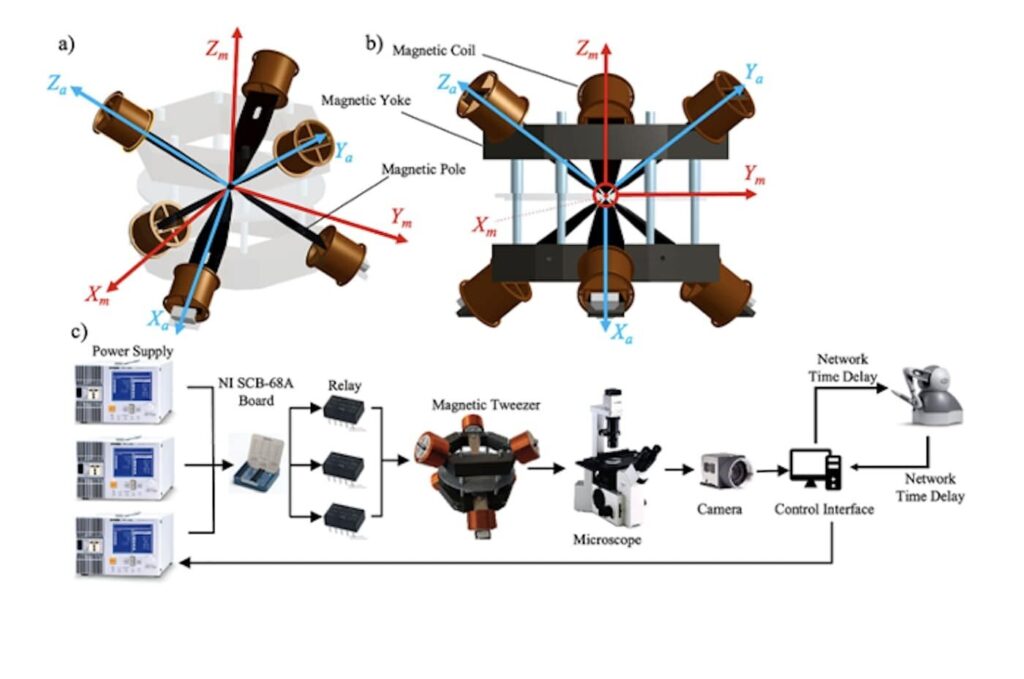Imagine if a doctor could remotely do a non-invasive, highly precise medical procedure on her patients using a tiny robot, or microrobot. With a device researchers from SMU and George Washington University created, that is one step closer to reality.
“Using what we call a magnetic tweezer system, an operator will be able to precisely manipulate tiny robots in a liquid environment, even from long distances,” said SMU nanotechnology expert MinJun Kim, one of the creators of the device. “The system provides real-time feedback through a haptic device, allowing the operator to feel forces acting on the microrobots as they move or interact with their surroundings.”
This technology could also potentially be used for safe and precise drug delivery as well, said Kim, the Robert C. Womack Chair Professor in the Lyle School of Engineering at SMU and principal investigator of the BAST Lab.
“Since the microrobots are manipulated externally using magnetic fields, there’s no need for invasive tools or procedures,” he said. “This allows treatments to be delivered exactly where they are needed in a controlled and non-invasive way, reducing risks to surrounding healthy areas.”
Safer, more precise procedures with microrobots
Microrobots are miniature robots that are made using nanotechnology. They show promise in several medical applications, such as surgery, targeted drug delivery and biopsy. But because of safety and ethical concerns, there is a growing interest to have a human involved with controlling microrobotic systems.
Magnetic tweezers could open the door for so-called “human-in-the-loop” microrobotic procedures.
“By keeping the operator in control, the system ensures safer interactions, while also providing the precision needed for sensitive applications,” Kim said.

Kim built the device with help from Chung Hyuk Park, who leads the Assistive Robotics and Tele-Medicine (ART-Med) Lab at George Washington University; Yasin Cagatay Duygu, a Ph.D. candidate at SMU’s Mechanical Engineering; Xiao Zhang, a former SMU research assistant and now a system engineer at New York Air Brake; and Baijun Xie, a research assistant at George Washington University.
The researchers published a study on the device in the journal Nanotechnology and Precision Engineering.
The magnetic tweezer system operates by generating magnetic fields using a specialized coil setup, which controls the movement of microrobots made of magnetic materials. These fields were found to work on microrobots more than 1,300 miles away, making it possible to use them for remote medical procedures.
-

SMU Ph.D. candidate Yasin Cagatay Duygu (left) and MinJun Kim, Robert C. Womack Chair Professor in the Lyle School of Engineering at SMU and principal investigator of the BAST Lab, use the magnetic tweezer system to move microbots. Credit: SMU
-

SMU Ph.D. candidate Yasin Cagatay Duygu uses the haptic device, which allows an operator to control how the microrobots move. Credit: SMU
Real-time microrobot monitoring and control
As part of this magnetic tweezer system, a haptic device—similar to a joystick—allows an operator to control how the microrobots move.
“As microrobots move in the liquid or interact with objects, their motion is tracked through image processing,” Duygu explained. “Using the image data, the magnetic tweezer system recreates the environment in 3D, allowing it to calculate the forces acting on the microrobots.”
This information is then sent to the haptic device, enabling the operator to feel and see the environment in real-time. To ensure stability and smooth movement, even with disruptions in its environment, the device uses Time Domain Passivity Control in an innovative way to analyze and manage energy flow continuously.
Kim—a Senior Member of the National Academy of Inventors—said the magnetic tweezer system combines precise magnetic control with haptic feedback, creating a hands-on way to interact with micro-scale systems.
“The system allows operators to make decisions in real-time based on what they feel and see, improving accuracy and control,” he said.


